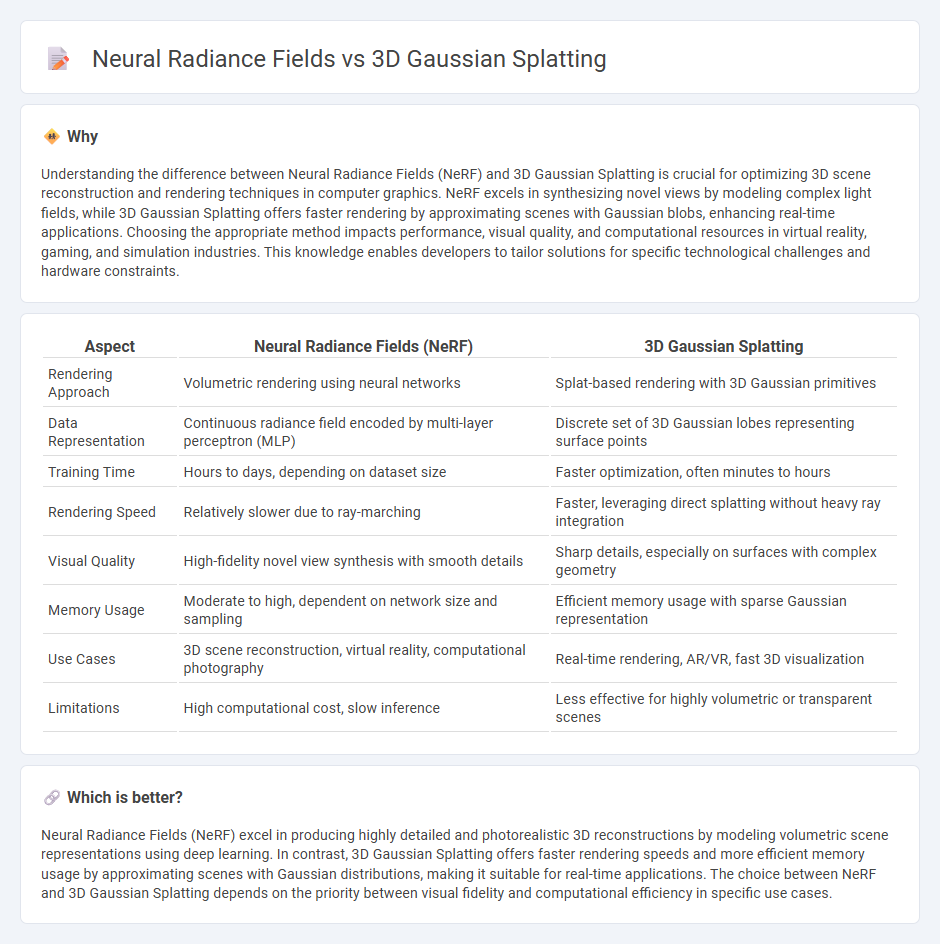
Neural Radiance Fields (NeRF) enable photorealistic 3D scene reconstruction by modeling volumetric light fields using deep learning, providing detailed view synthesis from sparse images. In contrast, 3D Gaussian Splatting represents scenes through a cloud of ellipsoidal Gaussians optimized for efficient rendering and dynamic scene editing. Explore the advantages and applications of these cutting-edge 3D visualization techniques to understand their impact on computer graphics and virtual reality.
Why it is important
Understanding the difference between Neural Radiance Fields (NeRF) and 3D Gaussian Splatting is crucial for optimizing 3D scene reconstruction and rendering techniques in computer graphics. NeRF excels in synthesizing novel views by modeling complex light fields, while 3D Gaussian Splatting offers faster rendering by approximating scenes with Gaussian blobs, enhancing real-time applications. Choosing the appropriate method impacts performance, visual quality, and computational resources in virtual reality, gaming, and simulation industries. This knowledge enables developers to tailor solutions for specific technological challenges and hardware constraints.
Comparison Table
| Aspect | Neural Radiance Fields (NeRF) | 3D Gaussian Splatting |
|---|---|---|
| Rendering Approach | Volumetric rendering using neural networks | Splat-based rendering with 3D Gaussian primitives |
| Data Representation | Continuous radiance field encoded by multi-layer perceptron (MLP) | Discrete set of 3D Gaussian lobes representing surface points |
| Training Time | Hours to days, depending on dataset size | Faster optimization, often minutes to hours |
| Rendering Speed | Relatively slower due to ray-marching | Faster, leveraging direct splatting without heavy ray integration |
| Visual Quality | High-fidelity novel view synthesis with smooth details | Sharp details, especially on surfaces with complex geometry |
| Memory Usage | Moderate to high, dependent on network size and sampling | Efficient memory usage with sparse Gaussian representation |
| Use Cases | 3D scene reconstruction, virtual reality, computational photography | Real-time rendering, AR/VR, fast 3D visualization |
| Limitations | High computational cost, slow inference | Less effective for highly volumetric or transparent scenes |
Which is better?
Neural Radiance Fields (NeRF) excel in producing highly detailed and photorealistic 3D reconstructions by modeling volumetric scene representations using deep learning. In contrast, 3D Gaussian Splatting offers faster rendering speeds and more efficient memory usage by approximating scenes with Gaussian distributions, making it suitable for real-time applications. The choice between NeRF and 3D Gaussian Splatting depends on the priority between visual fidelity and computational efficiency in specific use cases.
Connection
Neural Radiance Fields (NeRF) and 3D Gaussian Splatting are interconnected through their shared goal of enhancing 3D scene representation and rendering. NeRF utilizes deep learning to model volumetric scenes by estimating radiance and density at continuous spatial locations, while 3D Gaussian Splatting represents scenes using probabilistic point clouds with Gaussian kernels for efficient rendering and interpolation. Combining NeRF's accurate scene reconstruction with Gaussian Splatting's computational efficiency results in faster, high-quality 3D visualization and novel view synthesis.
Key Terms
Scene Representation
3D Gaussian splatting represents scenes using a compact mixture of Gaussian distributions, enabling efficient and continuous volumetric rendering with fewer computational resources compared to neural radiance fields (NeRFs), which rely on dense neural networks to model scene radiance and geometry. This Gaussian-based approach excels in handling sparse data and allows for faster real-time rendering through simplified spatial representations, while NeRFs offer higher fidelity in capturing intricate light interactions and fine geometric details. Explore more to understand the trade-offs and applications of these cutting-edge scene representation techniques in computer graphics and augmented reality.
Rendering Efficiency
3D Gaussian splatting significantly enhances rendering efficiency by representing scenes with sparse Gaussian primitives, reducing computational load compared to Neural Radiance Fields (NeRF) that rely on dense volumetric sampling and complex neural networks. This method accelerates rendering speed while maintaining high-quality visuals, making it suitable for real-time applications and interactive environments. Explore the latest research to understand how 3D Gaussian splatting outperforms NeRF in efficient rendering workflows.
View Synthesis
3D Gaussian splatting accelerates view synthesis by representing scenes with continuous Gaussian primitives, enabling faster and more efficient rendering compared to the dense volumetric sampling of neural radiance fields (NeRF). NeRF excels in producing high-fidelity, photorealistic images through complex light-field modeling but often requires extensive training and slower inference times. Explore how these emerging methods transform view synthesis with their distinct approaches in efficiency and visual quality.
Source and External Links
Gaussian splatting - Wikipedia - 3D Gaussian splatting is a volume rendering technique extended to dynamic scenes as "3D Temporal Gaussian splatting," enabling real-time, high-resolution rendering of dynamic 3D scenes by modeling Gaussian primitives with time-based deformation and motion, used in applications from text-to-3D generation to autonomous driving simulations.
Introduction to 3D Gaussian Splatting - Hugging Face Blog - 3D Gaussian Splatting is a rasterization technique that represents scenes as numerous 3D Gaussian primitives, each defined by position, covariance (shape/scale), color, and transparency, allowing the fast and realistic rendering of complex 3D environments by drawing millions of splats instead of traditional triangles.
Gaussian splatting at Pix4D: a new era of 3D visualization - Gaussian splatting improves 3D visualization and point cloud quality by modeling scenes with soft, semi-transparent Gaussian "splats" instead of hard edges, resulting in photorealistic, smooth, and detailed 3D models widely useful in mapping and industry applications.
 dowidth.com
dowidth.com